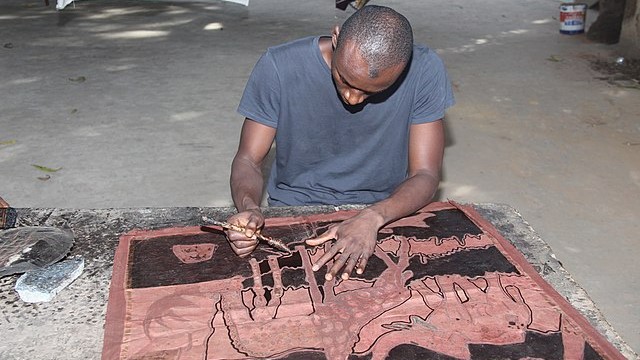In the crowded lanes of Banjul’s markets and in the quieter workshops scattered across rural villages, craftsmanship remains a cornerstone of Gambian life. Here, artistry is not simply a trade; it is a living inheritance, passed from generation to generation, binding communities together through skill, symbolism, and shared identity.
Woodcarvers, often working with local mahogany or rosewood, shape masks, stools, and intricate sculptures that reflect a blend of spiritual belief and cultural storytelling. The process is painstaking. Hours may be spent coaxing detail from raw wood, chiseling patterns that echo motifs long associated with Mandinka, Jola, or Wolof traditions. Each carving carries a resonance that is both aesthetic and historical, linking present-day artisans to ancestors who used similar tools and techniques.
Textile work, equally vibrant, animates the Gambian artisan landscape. Boldly dyed batiks and woven cloths splash markets with color—indigo blues, fiery oranges, and sunlit yellows—each hue carrying social and symbolic weight. Tailors and fabric makers often work side by side in cooperative spaces, their looms clattering while dye baths steam in the midday heat. Patterns, sometimes geometric, sometimes figurative, can speak of status, lineage, or regional identity. In many towns, the finished garments serve as both fashion and cultural statement, worn in ceremonies and everyday life alike.
The artisan economy is also a site of social change. Women, increasingly central to these communities, are finding new opportunities in workshops that once were male-dominated. Their involvement broadens both the scope of the crafts and the stability of household incomes, reflecting a wider Gambian movement toward gender equity. Craft collectives and cooperatives often emphasize training programs, ensuring that traditional techniques endure while also creating economic pathways for younger generations.
Markets provide the most visible showcase for these efforts. In Banjul, Serrekunda, and Brikama, visitors and locals alike sift through stalls laden with handwoven baskets, leather goods, and jewelry crafted from recycled materials. The atmosphere is vibrant—traders call out, haggling rises and falls, and the smell of grilled street food mingles with the sharp tang of fabric dye. Every sale in these spaces sustains not only individual families but also the cultural infrastructure that allows such artistry to flourish.
What sets Gambian artisans apart is not merely the range of their work but the sense of continuity it preserves. A carved mask or a piece of hand-dyed fabric is never just an object; it is part of a larger narrative, one that links ancient traditions with contemporary resilience. In a nation where oral history and artistic expression are deeply entwined, each crafted item becomes another thread in the fabric of cultural memory.


